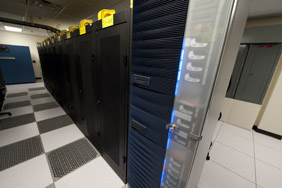Latest News
Sub Navigation
Experience the interactive tour of our initiatives.
TAKE THE TOURSlashing Energy Consumption With a Blade
It is about the size of an NFL lineman, has the memory of thousands of elephants and survives on a low-energy diet.
Say hello to the House data center's blade frame, a poster child for green computing.
It is basically a stack of high-capacity servers or "blades," each of which can handle up to 40 conventional servers-worth of data. At full capacity, the unit could reduce the House's server computing energy bill by more than 80 percent and save untold millions of dollars in IT contractor salaries.

So why are they called blades? "Some IT guy somewhere probably thought it would be cool," says Jack Nichols, director of House Information Resources' Enterprise Operations department.
Nichols is the blade frame's proud father. He and his IT team have shepherded the unit and data consolidation from an idea to a rapidly spreading reality.
Whereas the data center once had more than 300 whirring servers sucking down 500,000 watts of energy, there are now only about 30 servers sipping 125,000 watts. Whereas all Member offices once ran their own individual 400-watt servers, many now consolidate their servers on the 800-watt blades. The combined energy savings have cut the House's power bill by about $1,000 a day.
Blades pool CPU and memory resources, and then allot them to individual servers as needed. Like all technology, blade power and capacity will only grow if and when HIR purchases new blades in the future.
The blade frame concept met some initial skepticism from Members concerned about the safety and security of pooling data. "The perception is, if it's behind their locked door, it's safe," Nichols says. In actuality, a blade frame is as safe as or safer than individual servers because it is backed up daily, replicated at the House's emergency data center and uses separate, sophisticated encryption for each office's data.
As word of the blade frame's advantages has spread, the number of Member offices using it or waiting to use it has grown exponentially.
Before Nichols's team could do all this, they had to consolidate information on the servers of the Office of the Chief Administrative Officer, the body in charge of HIR. The effort, beginning in 2005, would eventually save enough power and data center space to run the new blade frame and make the current cost savings possible. Nichols describes the move as a chapter in IT evolution, the descendant of mainframe computers and the next step in data consolidation.
"We're taking advantage of emerging technologies to make our own organization better," Nichols says. "In so doing, we're able to offer new and better services to our member offices."
Related Videos
Did You Know?

Energy Efficient Window Upgrades
We are reducing weather impact on cooling systems by installing solar-reflective window film, replacing inefficient windows and installing solar shades in all House office buildings.
Our Intitiatives